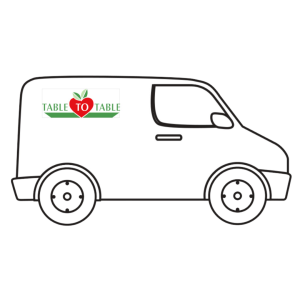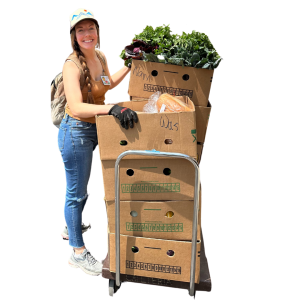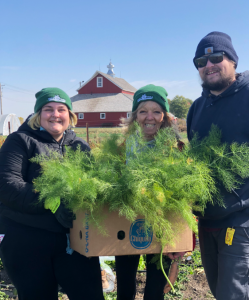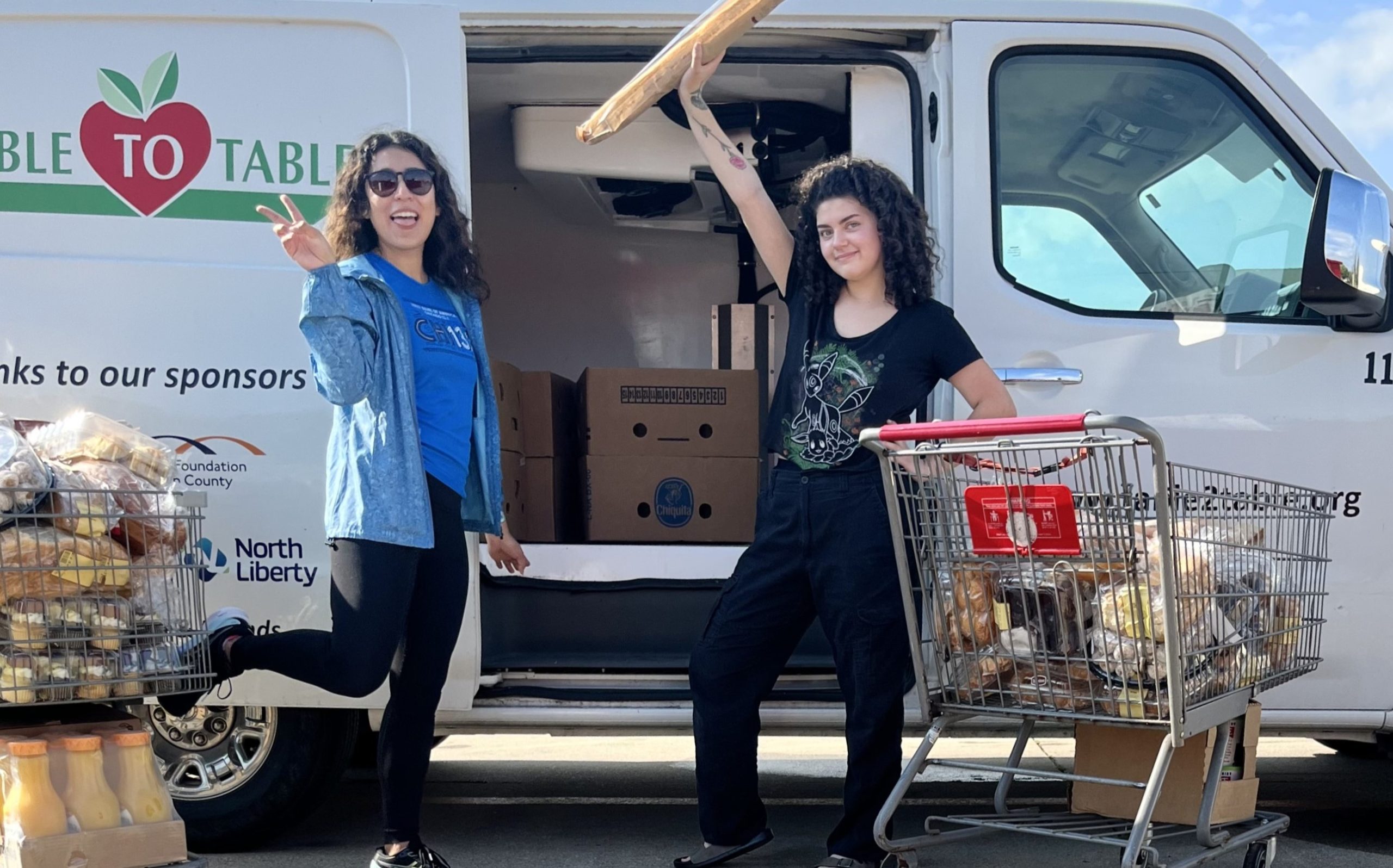
Volunteers are the key to vital connections
This article appears in Table to Table’s 2023 Impact Report.
T2T volunteers truly embody a passion for recovering food and delivering it to our neighbors. Along the way, they develop strong relationships with those who donate and receive the rescued food.

Two best pals who volunteer together on a weekly Saturday morning food rescue route, Cheyenne and Jasmine, chat with produce department staff when they pick up donations. They know each other by name and the employees seek this volunteer pair out each Saturday to make sure they don’t miss any food set aside for donation.
Have we mentioned Mary Palmberg? Well, we’re going to again. Mary is T2T’s longest-serving volunteer, now in her 25th year. Throughout her roles at T2T since 1998, she’s been an ambassador to our community, using every opportunity to promote and garner support for our mission. Mary builds great relationships with food donors, increasing their donations and commitment to our mission. She makes T2T deliveries memorable for recipient agencies and their volunteers, expressing sincere and heartfelt gratitude for their partnership and work.
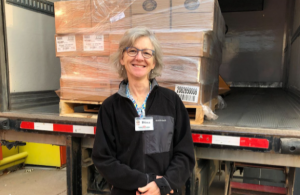
Dina Janzen has driven T2T’s straight truck to deliver pallets of food for years. “I absolutely love connecting with the people inside the back doors of warehouses, stores, and food pantries every week,” she says. “I find it fascinating to observe how the complex systems that exist to rescue all this food are constantly adapting. My part of this system is simple, but my role feels essential.”
T2T volunteers enjoy forging global connections, too. T2T was fortunate to host Fellows of the Mandela Washington Fellowship for Young African Leaders through the University of Iowa’s International Institute for Business for two days this year. Fellows recovered food on routes and gleans alongside T2T volunteers and discussed the innovative work they’re doing in their own communities in countries across Africa – a great learning experience for all involved.
T2T volunteers are essential to retail food rescue, fleet prep, driving our straight truck, office work and data, gleans at farms and orchards, community outreach, free produce stands, and more! Learn how to get involved.
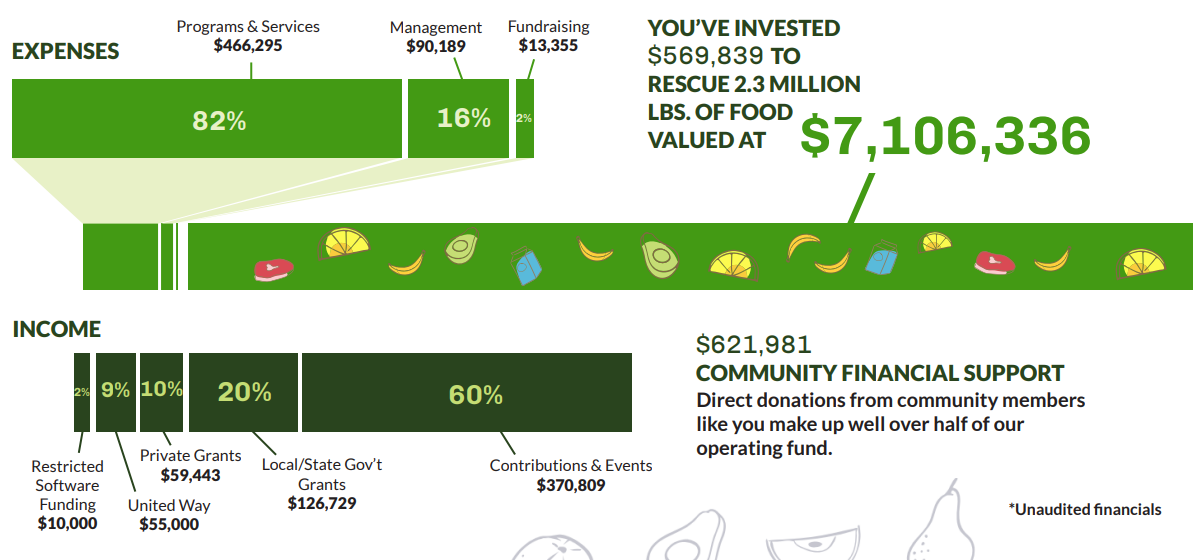
FY23 Financials
July 2022 – June 2023
Expenses: You’ve invested $569,839 to rescue 2.3 million pounds of food, valued at $7,106,336.
Income: $621,981 in community financial support; direct donations from community members like you make up well over half of our operating fund.
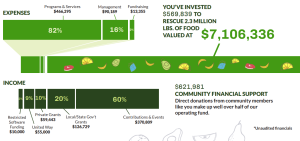
Expenses
Programs & Services: $466,295 (82%)
Management: $90,189 (16%)
Fundraising: $13,355 (2%)
Income
Contributions & Events: $370,809 (60%)
Local and State Government Grants: $126,729 (20%)
Private Grants: $59,443 (10%)
United Way: $55,000 (9%)
Restricted Software Funding: $10,000 (2%)
*unaudited financials

2023 food rescue at a glance
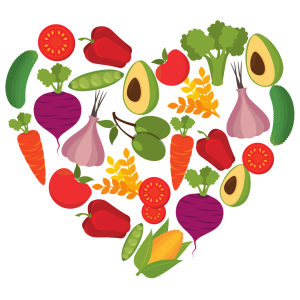
T2T rescued 2,287,968 pounds of food this year, a 4% increase over the previous year.
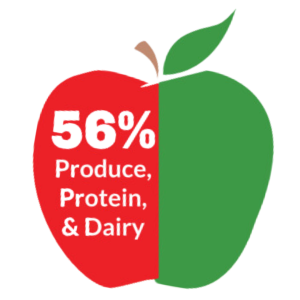
56% of the food we rescued was produce, protein, and dairy.
125 stores, warehouses, processors, farms, markets, and cafeterias donated food.
T2T coordinated
14,000+ food pickups and deliveries.
Volunteers rescued food from grocery stores, warehouses, & dining halls on 2,300 routes.
Table to Table food reached more than 25,000 neighbors this year. Nearly ⅓ were children.
Thanks to new software you helped fund, we are using even more data to drive our work. Join us for a virtual demonstration of FoodForce.
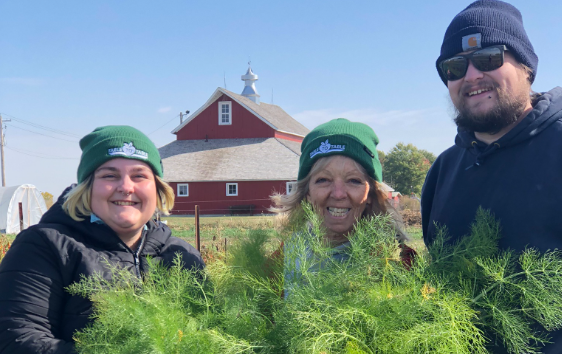
It Takes a Village…to raise a Food Rescue to the Next Level
It’s been a year of transition and bringing enthusiastic new team members into the operation at Table to Table. We’d like to take a few minutes to recognize the contributions of the staff, student leaders, and AmeriCorps team since last summer.
Staff Team Transitions & Additions
We bid a fond farewell to Program Coordinator Ezra Schley in July 2022, who had been with us since summer 2020. That September, Chaim Jensen joined T2T as our newly-titled Logistics & Relationships Coordinator. Having worked on the supply side of the food system for years, Chaim understands all too well the barriers and opportunities to reduce food waste. His work also helps T2T build and maintain relationships with food donor partners. He says he “was attracted to the problem-solving aspect of the position, knowing that no two days are the same.” He’s right: that’s the very nature of food rescue!
T2T added a new (and proven essential!) full-time staff position to our team in November 2022. Operations Coordinator Elizabeth Wagner was first introduced to T2T in her work at longtime food donor partner New Pioneer Co-op, where she developed an interest in the local food system and got to know food vendors and producers. “I was really drawn to T2T’s community-focused approach and dedication to fighting food waste,” she says. “Community engagement and sustainability are two passions of mine.” Her new position improves our software and data abilities, supports our fleet and facility, and ensures daily operations run smoothly to support T2T’s growth.
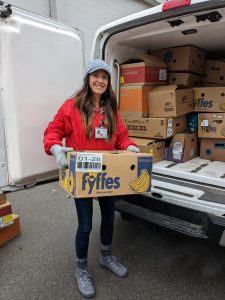
AmeriCorps Service Members
At the end of 2022, Table to Table bid a fond farewell to our Data Systems Coordinator, Alex Courtney. Each day since we’ve utilized software he helped us tailor to our specific food recovery needs during his AmeriCorps service term and later as a part-time staff member. At the beginning of Alex’s service in early 2021, T2T was tracking over two million pounds of 10,000+ food pick-ups and deliveries, 150 partnerships, and hundreds of volunteers on paper and in Excel spreadsheets. Alex ushered our technology into the twenty-first century, enabling us to analyze all sorts of data points that tell us about food sourcing, distribution, and to understand critical patterns in the hunger relief network as a whole. With this data at our fingertips, we can take action to improving our network and continue to connect as much nutritious food as possible to our most vulnerable neighbors. (Join a virtual demonstration of this technology in action on November 29!)
In November 2022, Nora Garda completed her second service term as AmeriCorps Gleaning Coordinator through the ISU 4-H Outreach program. Nora helped lead T2T to recovering more than 40,000 pounds of local produce during the 2022 growing seasons. Hear her love for connecting fresh food from the growing community to our neighbors straight from Nora: she wrote this insightful reflection on a gleaning season after her first service term in 2021.
Throughout summer 2022, two local produce recovery AmeriCorps service members supported this work. Molly Suter worked closely with Nora in gleaning coordination to schedule and lead gleans with local farmers and volunteers. Alyssa Schaeffer planned and implemented T2T’s free produce stands. She helped create a regular produce stand schedule and reached additional folks through free produce coolers for self-service at community events.
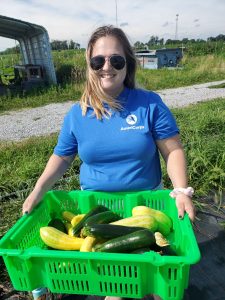
Ngonyo Mungara joined the team as a COVID-19 Recovery AmeriCorps member during the first half of 2023 for general food rescue program support to support route based rescue and increase food donations. “It was a pleasure to get to know volunteers from so many different walks of life and learn why they like volunteering for Table to Table,” she says of one of her favorite aspects of the role. “I liked that each day was something different; you never get bored at T2T!” During her tenure she took our first steps in partnering with grocers offering specific cultural foods. She is excited to see this program to access culturally appropriate foods continues to grow. She notes, “Johnson County is becoming an increasingly diverse area and there is a need for more culturally relevant foods in pantries to support these communities.”
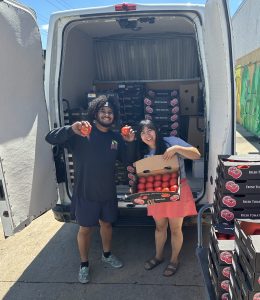
Practicum & Internship Students
Amiya Jones sought out T2T as a partner for completing her Masters in Social Work practicum during the 2022-2023 school year. She was excited to learn more about environmental and food justice work in nonprofits through working closely with T2T executive director Nicki Ross. “I have always been passionate about food insecurity and building self sustaining communities within my journey as a social worker,” she said of her role. Amiya supported T2T’s efforts to revise our mission statement and implement values, practices, and training to support equity and access initiatives.
Lauren Wegmann, a student in marketing and philanthropy, jumped right into helping T2T plan our annual dinner in spring 2023. Her enthusiasm helped T2T surpass our fundraising goal for the event!
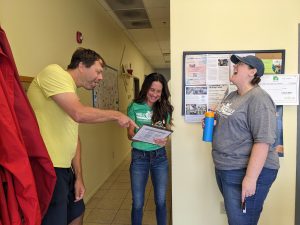
With all those transitions, the rest of the crew can’t be overlooked: we continued to have throughout fiscal year 2023 our seasoned Executive Director Nicki Ross, Communications & Development Coordinator Anne Langebartels (now Hlavacek), Volunteer Coordinator Jared Long, part-time Bookkeeper, Celia Eckermann, and Programs & Services Manager Allison Gnade, who celebrated one year in the role this past February.
View our current staff & Board of Directors team on our website.
Remembering Our Friend and Fellow Food Rescuer Kenn Bowen

We’re thinking of Kenn and Pat this week as we get our produce stand schedule started for the summer. Kenn & Pat volunteered at our Free Produce stands during the summer months, building community and distributing fresh produce with a smile and a kind word. This was in addition to faithfully covering their weekly route. Together, Kenn and Pat were an unstoppable duo, always willing to lend a helping hand wherever it was needed.
At a gathering of T2T volunteers last summer at Big Grove, AmeriCorps member Alyssa remembers her first encounter with Kenn, who would become a regular volunteer in the program she led: “From the moment we struck up a conversation, it was clear that Kenn had a knack for storytelling and ‘dad’ jokes. He effortlessly embodied the welcoming and inclusive nature of Table to Table, making everyone around him feel at ease.”

Each time he saw Kenn, T2T Volunteer Coordinator Jared Long would share his own weekly joke, and it became a lighthearted goal to elicit an eye roll from Kenn — a small victory that Jared cherished. Kenn’s quick wit and dry humor reminded us not to take ourselves too seriously and added a touch of levity to our work. His clever quips, travel stories, and engaging discussions on current events made him an unforgettable presence.
Kenn never held back from sharing his thoughts and opinions, providing valuable insights and feedback. His honesty and engagement in our work were qualities that we greatly respected. We knew that when Kenn expressed his views, it came from a place of genuine care and a desire to make a difference. His candidness was appreciated in the environment of open dialogue and growth T2T works to cultivate.
We mourn the loss of a dear friend, a dedicated volunteer, and a man of integrity. But let us also celebrate the profound impact he had on our community. In honor of Kenn Bowen, let us carry his spirit forward. Let us continue the vital work he began, being a true friend, advocating and lifting the voices of our most vulnerable neighbors, and bringing comfort to those in need. May we approach our tasks with the same dedication, passion, and humor. His legacy of compassion and service lives on in our hearts and in the continued efforts of Table to Table.


